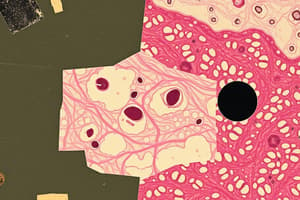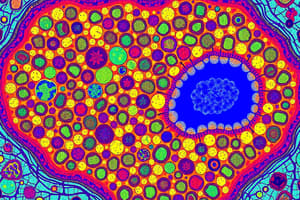Podcast
Questions and Answers
Which characteristic is NOT associated with epithelial tissue?
Which characteristic is NOT associated with epithelial tissue?
- It is made up of closely packed cells.
- Epithelial cells can regenerate quickly.
- It contains numerous blood vessels. (correct)
- It is avascular.
What type of epithelium is responsible for secretion?
What type of epithelium is responsible for secretion?
- Neuroepithelium
- Myoepithelium
- Surface epithelium
- Glandular epithelium (correct)
Which type of epithelium is characterized by having a single layer of cells?
Which type of epithelium is characterized by having a single layer of cells?
- Glandular epithelium
- Stratified epithelium
- Simple epithelium (correct)
- Pseudostratified epithelium
Which statement describes the structural arrangement of stratified epithelium?
Which statement describes the structural arrangement of stratified epithelium?
What is a primary function of myoepithelium?
What is a primary function of myoepithelium?
What is the primary function of stratified squamous epithelium?
What is the primary function of stratified squamous epithelium?
Which type of epithelium has dome-shaped cells that may be binucleated?
Which type of epithelium has dome-shaped cells that may be binucleated?
Which site is primarily associated with non-keratinized stratified squamous epithelium?
Which site is primarily associated with non-keratinized stratified squamous epithelium?
What characterizes stratified columnar epithelium?
What characterizes stratified columnar epithelium?
In which location would you most likely find ciliated epithelium?
In which location would you most likely find ciliated epithelium?
What is a typical feature of transitional epithelium when the bladder is full?
What is a typical feature of transitional epithelium when the bladder is full?
Which type of epithelium is least likely to be found in gland ducts?
Which type of epithelium is least likely to be found in gland ducts?
What is a characteristic of keratinized stratified squamous epithelium?
What is a characteristic of keratinized stratified squamous epithelium?
What type of epithelium is important for gas and fluid exchange?
What type of epithelium is important for gas and fluid exchange?
Which type of epithelium is primarily found in the thyroid follicles?
Which type of epithelium is primarily found in the thyroid follicles?
What is the primary function of simple columnar epithelium in the stomach?
What is the primary function of simple columnar epithelium in the stomach?
What distinguishes pseudo-stratified columnar epithelium from other types?
What distinguishes pseudo-stratified columnar epithelium from other types?
Which sites are associated with simple columnar ciliated epithelium?
Which sites are associated with simple columnar ciliated epithelium?
Where is simple squamous epithelium found?
Where is simple squamous epithelium found?
What is a characteristic feature of simple cubical epithelium?
What is a characteristic feature of simple cubical epithelium?
What type of epithelium primarily functions in absorption within the intestine?
What type of epithelium primarily functions in absorption within the intestine?
Flashcards are hidden until you start studying
Study Notes
Epithelial Tissue
-
Epithelial tissue develops from three embryonic germ layers: ectoderm, mesoderm, and endoderm.
-
Epithelial cells rest on a basement membrane, which can be clear or non-clear.
-
Epithelial tissue is characterized by densely packed cells with minimal intercellular spaces.
-
Epithelial tissue is avascular, meaning it lacks blood vessels. It receives nutrition through diffusion from the underlying connective tissue.
-
Nerves can pass between epithelial cells.
-
Epithelial tissue has a high regeneration capacity.
Types of Epithelium
-
Surface epithelium: Forms continuous sheets that cover surfaces or line cavities.
-
Glandular epithelium: Cells secrete substances.
-
Neuroepithelium: Cells are specialized for receiving sensory stimuli.
-
Myoepithelium: Cells have contractile function.
Surface Epithelium
- Classified by the number of cell layers:
- Simple epithelium: Composed of a single layer of cells resting on the basement membrane.
- Stratified epithelium: Composed of multiple layers of cells.
Simple Epithelium
-
Simple squamous epithelium:
- Single layer of flat, thin cells with flattened nuclei.
- Functions:
- Facilitates easy movement of fluids and gases.
- Exchange of gases and fluids.
- Locations:
- Pleura, pericardium, and peritoneum (called mesothelium).
- Blood vessels and heart (called endothelium).
- Lung alveoli.
- Bowman's capsule of the kidney (filtration of body fluids).
-
Simple cuboidal epithelium:
- Single layer of cube-shaped cells with round nuclei.
- Functions:
- Secretion.
- Reabsorption.
- Locations:
- Thyroid follicles.
- Acini and small ducts of all exocrine glands (e.g., salivary glands).
- Convoluted tubules of the kidney.
-
Simple columnar epithelium:
- Single layer of tall, columnar cells with basal oval nuclei.
- Functions:
- Secretion.
- Absorption.
- Locations:
- Stomach (secretion).
- Intestine (absorption and secretion).
- Female genital system.
- Lower respiratory tract.
-
Simple columnar epithelium, ciliated:
- Single layer of tall, columnar cells with basal oval nuclei and cilia.
- Functions:
- Movement of substances along the surface.
- Locations:
- Intestine (may contain microvilli and goblet cells).
-
Pseudo-stratified columnar epithelium:
-
Simple epithelium where cells are crowded, with some tall cells with central nuclei and others short cells with basal nuclei.
-
Nuclei are present at multiple levels, giving the appearance of being stratified.
-
Types:
- Non-ciliated pseudo-stratified columnar epithelium:
- Locations: Vas deferens.
- Pseudo-stratified columnar epithelium with motile cilia and goblet cells:
- Locations: Upper respiratory tract (nose, trachea, and bronchi).
- Pseudo-stratified columnar epithelium with non-motile cilia (stereocilia):
- Locations: Epididymis, male urethra.
- Non-ciliated pseudo-stratified columnar epithelium:
-
Stratified Epithelium
-
Stratified squamous epithelium:
- Composed of multiple layers of cells, with the top layer being flat.
- Functions: Protection.
- Types:
- Keratinized stratified squamous epithelium:
- Locations: Skin, ear.
- Non-keratinized stratified squamous epithelium:
- Locations: Oral cavity, cornea, esophagus.
- Keratinized stratified squamous epithelium:
-
Transitional epithelium (uroepithelium):
-
Multiple layers of cells with the ability to change shape.
-
Relaxed (empty): 6-8 layers of cells with cuboidal shape in the basal layer and dome-shaped cells at the surface.
-
Full (stretched): 3-4 layers of cells with flattened cells at the surface, with some cells potentially binucleated.
-
Functions: Protection.
-
Locations: Ureter, urinary bladder.
-
Unique characteristics:
- May contain mucous on the surface.
- Basement membrane is non-clear and non-wavy.
-
-
Stratified columnar epithelium:
- Less common type of epithelium.
- Composed of a few layers with the top layer being columnar cells.
- Locations:
- Stratified columnar ciliated epithelium: Foetal esophagus.
- Stratified columnar non-ciliated epithelium: Recto-anal junction, large ducts of glands, male urethra (penile part).
-
Stratified cuboidal epithelium:
- Rare type of epithelium.
- Composed of two layers of cube-shaped cells.
- Locations: Sweat glands.
Studying That Suits You
Use AI to generate personalized quizzes and flashcards to suit your learning preferences.




